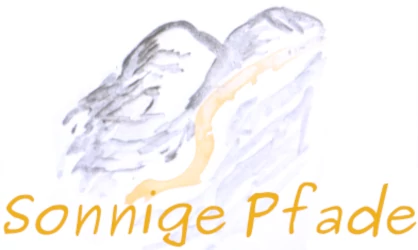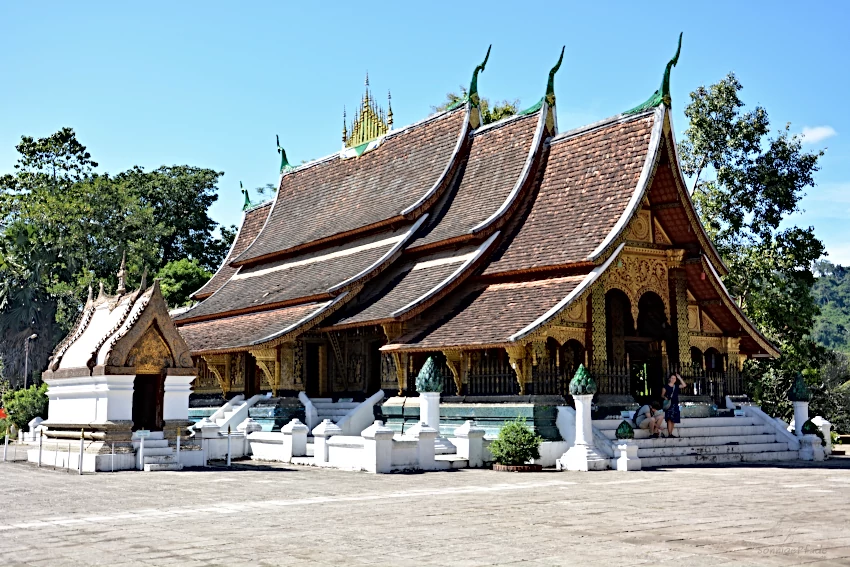
One of the most beautiful cities in Southeast Asia is the small Luang Prabang in the north of Laos. The former royal city on the upper reaches of the Mekong combines a multitude of Buddhist monasteries with the architectural charm of French colonial buildings. Since 1995, the old town center of Luang Prabang has been a UNESCO World Heritage Site.
[Contains *advertisement!]
Charming from early to late – in Luang Prabang on a discovery tour
The old town of Luang Prabang on a peninsula
The Mekong flows lazily under the hot sun in the north of Laos. There, where the Nam Khan flows into the Mekong in a wide loop, lies the old town of Luang Prabang on a peninsula. Like a dam, it juts out towards the confluence. On the Mekong, in the shade of the shore trees, river boats swing at anchor, a decrepit ferry carries, almost always crowded, pedestrians, cyclists, mopeds and even a few cars across the river to the western bank. Above the shore line are typical colonial houses from the 19th and the first half of the 20th century, left by the French as the „protecting power“ of the Kingdom of Laos. In between, especially on the „crest“ of the peninsula, there are several of the magnificent Buddhist monasteries that testify to the long religiously influenced culture in the Luang Prabang region.
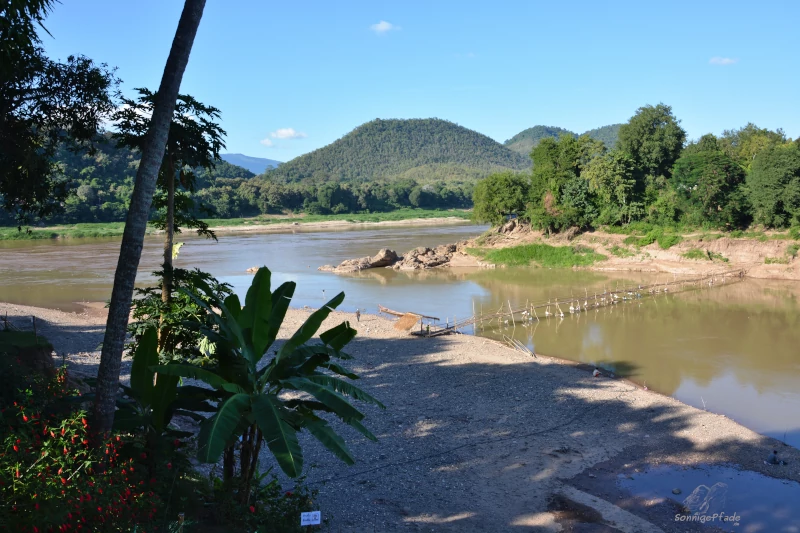
Since there is relatively little motorized traffic in this part of town, it is very nice to explore the old center on foot. A road, almost continuously provided with footpaths, runs along the banks of the Mekong and Nam Khan once around the peninsula and really invites you to explore. Many trees along the river banks provide shade and bearable temperatures. The whole ensemble is an experience worth seeing!
Colonial houses on Thanon Sisavangvong
Over the „crest“ of the peninsula stretches the main street Sakkarine Road, later Thanon Sisavangvong and opens up the entire world heritage area. However, this is less green and therefore recommended mainly for quiet morning walks in the cool or evening stroll. And this is especially worthwhile:
Around Thanon Sisavangvong in the old colonial houses are a number of restaurants, but also all kinds of stores that are interesting for travelers – tourist offices with local tour offers, souvenir – stores and vendors of various handicrafts, cooking studios to learn Laotian cuisine, etc.. It is interesting that also traders with organic food and other local products try to establish themselves.
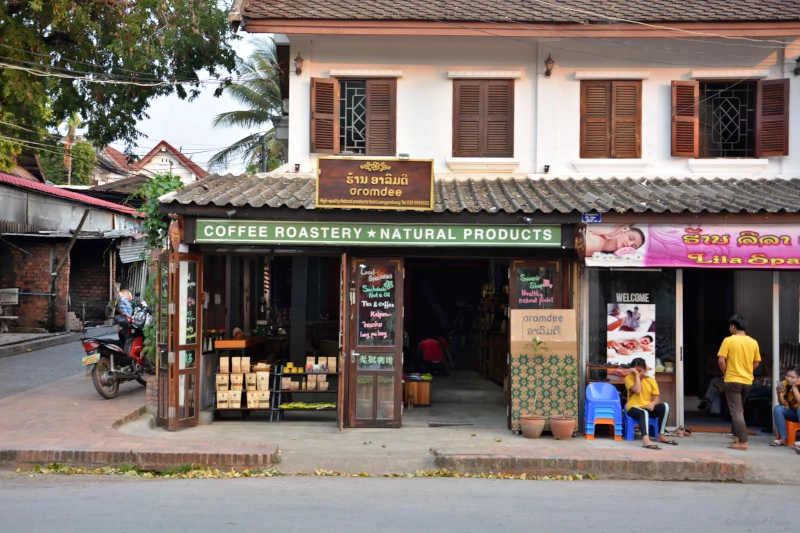
Night market, food market and sunset
At the southern part of the street below the Phousy mountain the night market opens every evening. There you will find not only the typical T-shirts with „Beer Lao“ print or other Laos motifs as well as some „China stuff“, but also local offers from painting to handicrafts, fabrics and textiles woven in the villages. In Laos often to be found are jewelry – items from war scrap. The latest hit in the course of the sustainability trend: reusable „straws“ made of bamboo.
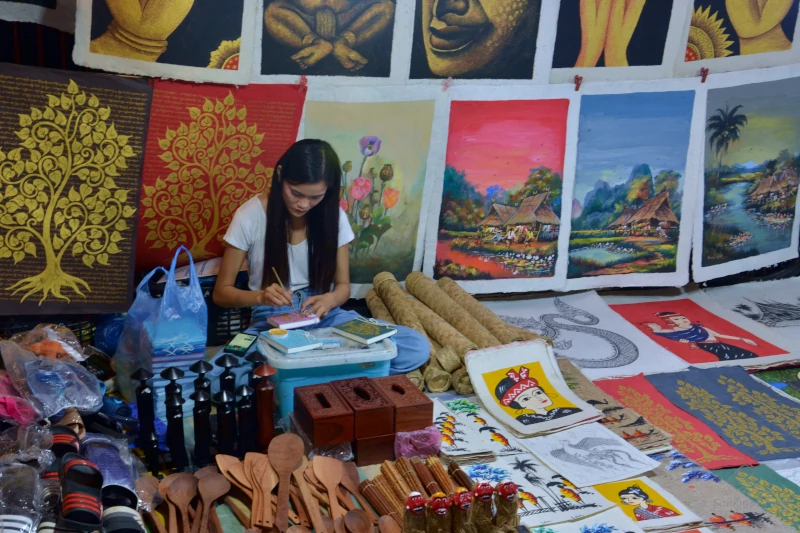
In some side streets there is the street food market, whose simple cookshops many visitors prefer even to the „established“ restaurants. From about 6 in the evening until around 10 p.m, these streets are the center of nightlife in Luang Prabang.
Strolling around evening Luang Prabang at sunset is one of the most memorable experiences in Laos in general. In the dry season, the sun colors palm trees and colorful colonial buildings particularly intensively at the „blue hour„. In addition, everywhere again properly awakens the life after the paralyzing heat of the day. And so many of the houses are illuminated, there is trading and storytelling, cooking and handicrafts, locals meet for evening study sessions, for example, also in English – courses with guests, market stalls open…
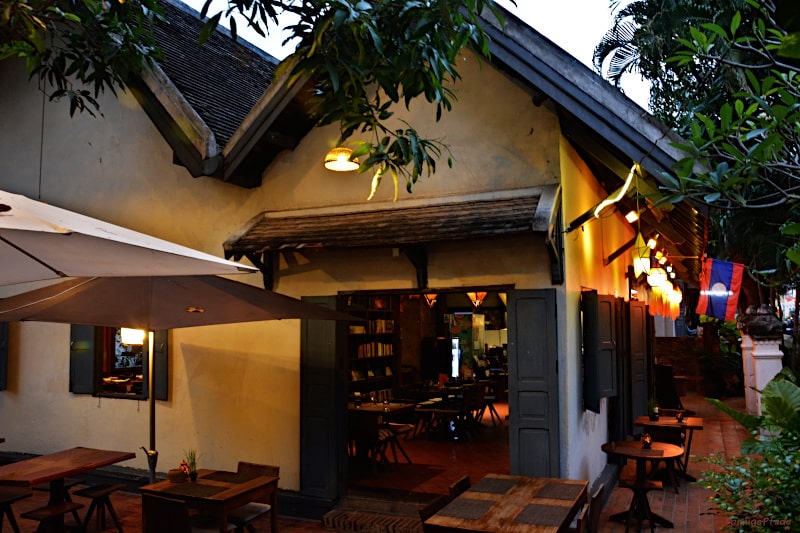
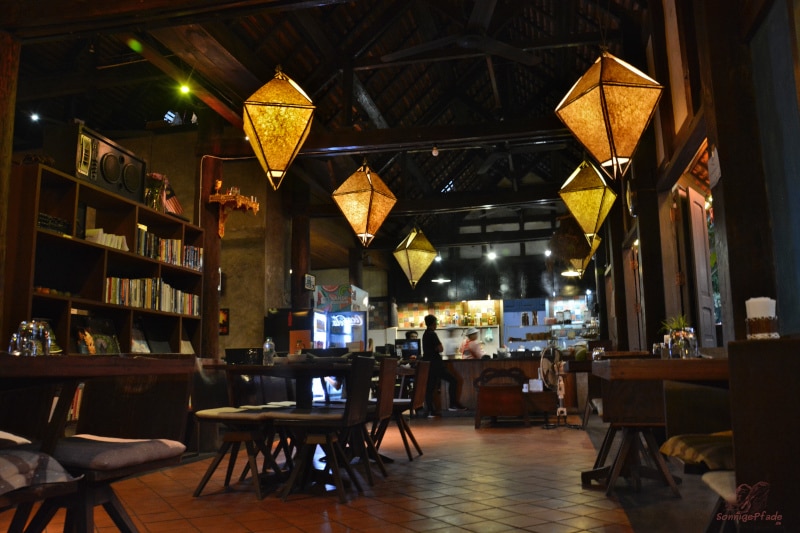
The Royal Palace of Luang Prabang in Laos – today National Museum
Also at the Thanon Sisavangvong, approximately opposite the most important ascent to the Phousy – mountain, is the old royal palace Ho Kham. Until 1975 Laos was a kingdom, then the communist Pathet Lao took power and dissolved the monarchy. As early as 1365, the kingdom of Lan Xang, the „Land of Millions of Elephants“, was created when the first Siamese kingdom of Sukhothai lost influence in the west and Fa Ngum, a vassal of the Khmer in Luang Prabang, became king. For his coronation, the new ruler received the Buddha statue Phra Bang from the Khmer of Angkor Wat, which gave him legitimacy and power and quickly made Luang Prabang a place of pilgrimage. Even today, the Buddha statue Phra Bang can be seen in a small temple Ho Phra Bang next to the Royal Palace.
The Lan Xang Kingdom existed until 1560, when King Setthathirat moved the capital to Vientiane as the north became increasingly embroiled in power struggles between Siam and the Burmese. Luang Prabang, however, always remained a royal city and became a spiritual center of the country through the settlement of numerous Buddhist monasteries.
The National Museum mainly displays furnishings and accessories of the kings. There is also a vehicle exhibition of royal traveling charriots at the royal palace.
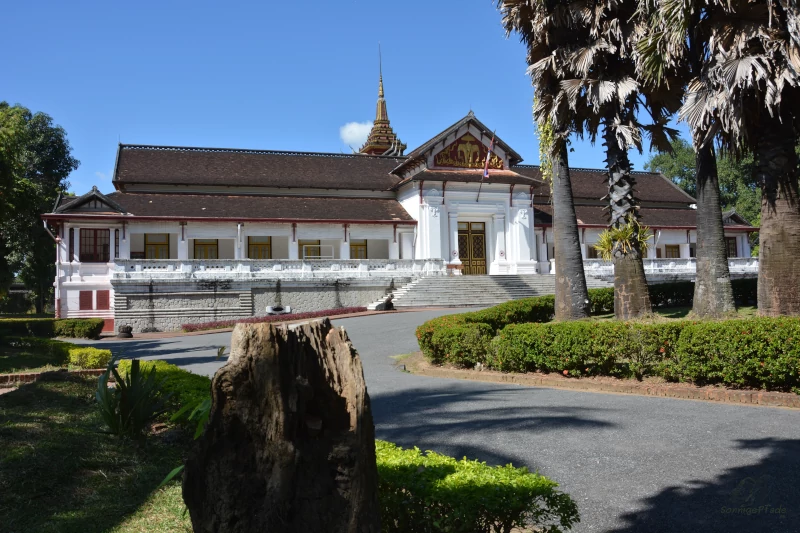
In the tourist season, a royal theater plays at the royal palace, which performs in the evenings, among other things, the „Search for Princess Sida“, a giant dance or the Nankeo ballet.
Another temple right next to the Royal Palace is Wat Mai Suwannaphumaham. The building is often called the most elaborately decorated of all temples in Luang Prabang. But this is certainly debatable, with the abundance of monasteries and temples there are many other gems and you should form your own opinion.
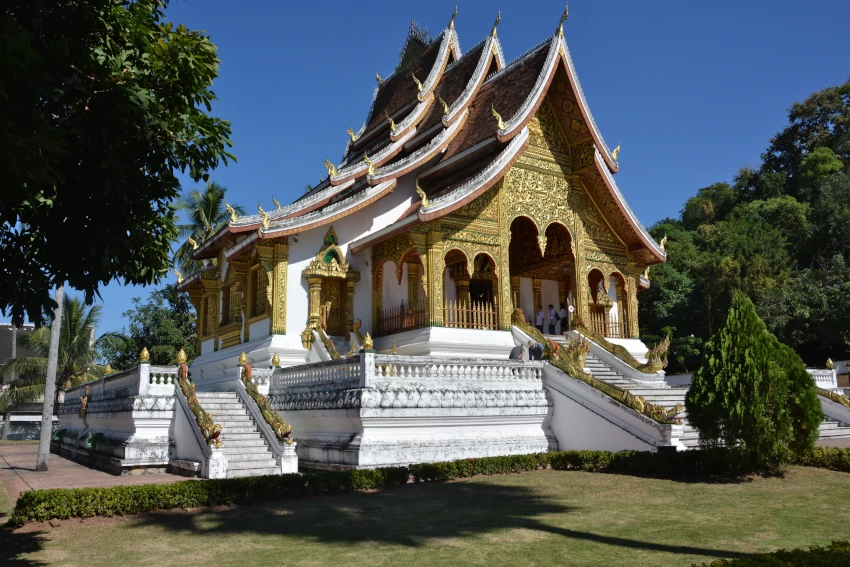

Mount Phousy and Wat Chom Si
Just opposite the old royal palace, in the middle of the historical center of Luang Prabang, rises the approximately 130 m high Phousy hill. This can be climbed via a staircase with 328 steps. This is worthwhile in any case, because up there you will not only find another temple, Wat Chom Si, which is also crowned by a good 20 m high gilded Chedi. From Phousy hill you have a wonderful panoramic view over Luang Prabang, the Mekong River and the surrounding mountains – once the morning haze has cleared. Many also use the outlook on „Mount Phousy“ as a viewpoint for the sunset.
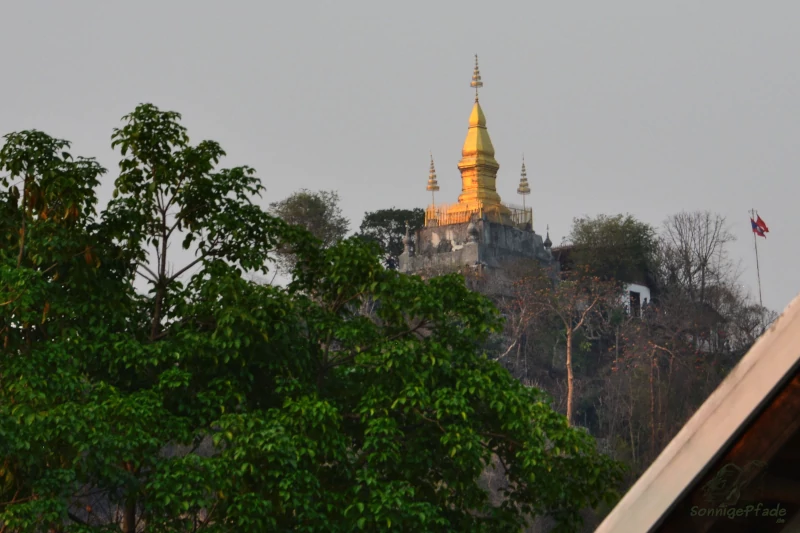
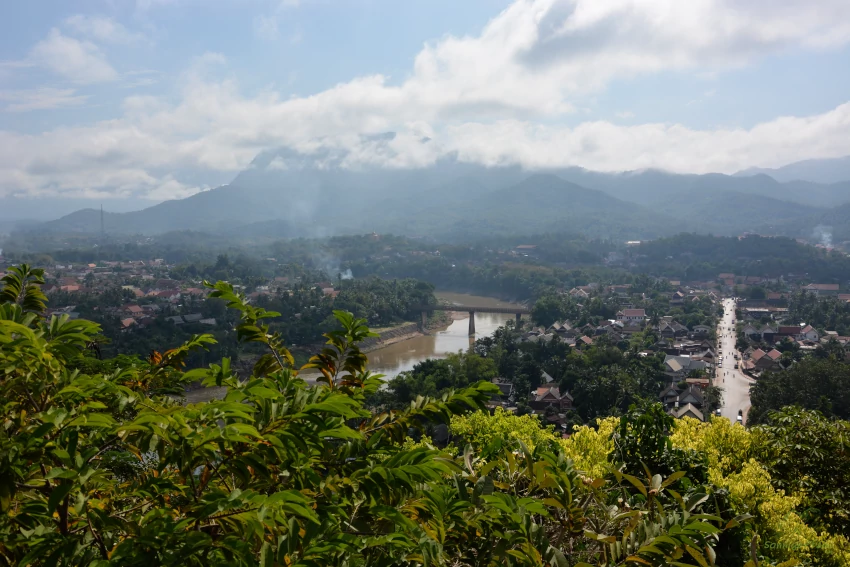
Museum Traditional Arts & Ethnology Centre TAEC
Worthwhile is also a visit to the small „Traditional Arts & Ethnology Centre„. This ethnological museum in Luang Prabang is a bit hidden and a bit uphill, so that some visitors probably pay no attention to this house by mistake. But especially for the guests from the „western hemisphere“ the TAEC offers a good insight into the diversity of the ethnic landscape in Laos and the northern Southeast Asia as a whole. After all, the Tai-Lao are just one ethnic group native to the region.
There are four ethnic language groups in Laos. Many small ethnic groups belonging to these language groups live in the mountainous region between Thailand, Burma/Myanmar, China and Vietnam. These differ culturally, sometimes significantly. The TAEC shows traditional folk costumes, handicrafts, everyday objects and, for example, musical instruments. Even an instrument workshop is reconstructed. The exhibition perhaps gives a little background to some of the folk art offerings available at the night market. Besides Tai Lao, Hmong, Yao-Mien or Yao-Mun also sell their products, especially from domestic textile production.
The TAEC Museum is open Tuesday to Sunday from 9 a.m. to 6 p.m.; Internet: www.taeclaos.org
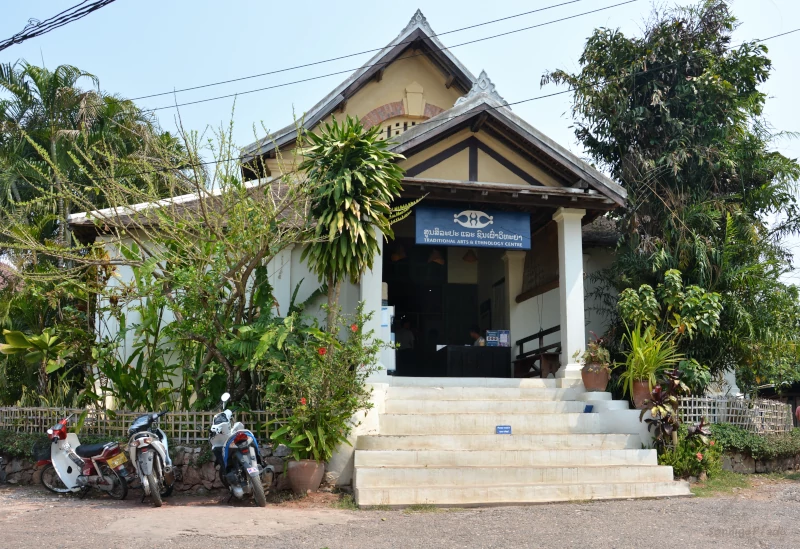
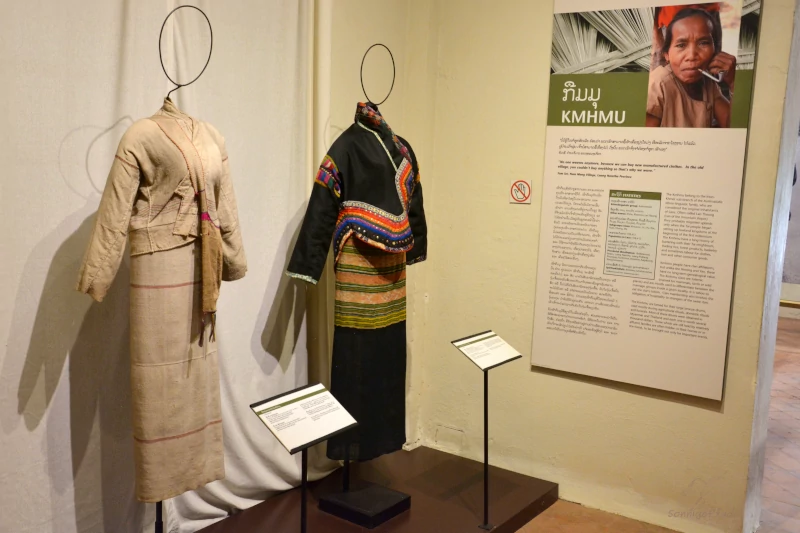

UXO – Information Center Luang Prabang
An unfortunately very sad chapter in the history of Laos is now over 45 years ago, but still hits the small country hard in many individual fates. In the shadow of the Vietnam War, Laos was murderously bombed by the US Air Force from 1964 to 1973. For nine years, every 8 minutes there was a bombing raid somewhere in the country. While in the south above all the Ho Chi Minh – path was the goal, over which the Southern Vietcong troops were supplied, in the north of Laos, e.g. in the environment of Luang Prabang the goal was to weaken the communist Pathet Lao. As so often, rather with the opposite result.
The bombardments were mainly with cluster munitions – in one drop – container were about 380 tennis ball sized „bombies“ which exploded over the landscape and sent out a deadly splinter – rain. It is assumed that up to 30% did not explode immediately. Many of the bombies still contaminate large parts of the country and there are still, almost 50 years after the war(!), monthly victims of exploding so-called UXO – unexploded ordnaries. Most affected are farmers tilling their fields and children who come across bombies while playing. Munitions contamination is one reason why Laos is such a poor country – many areas can only be used for agriculture or other purposes to a limited extent and „investors“ shy away from the risk.
With international help, Laos is trying step by step to clean up its land of the bombies and contain the dangers. In addition, information events are regularly held in all schools and children’s institutions with theater, film and visual lessons to warn even the youngest children of the dangers and to teach correct behavior when cluster munitions are found.
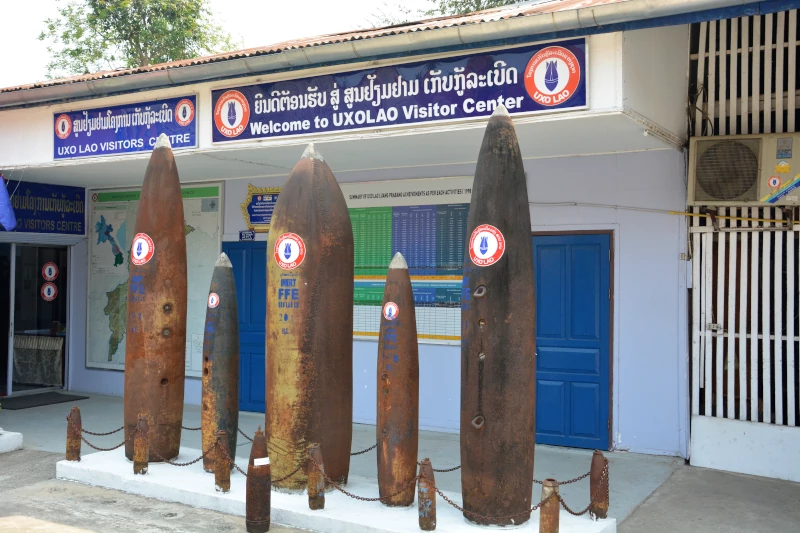
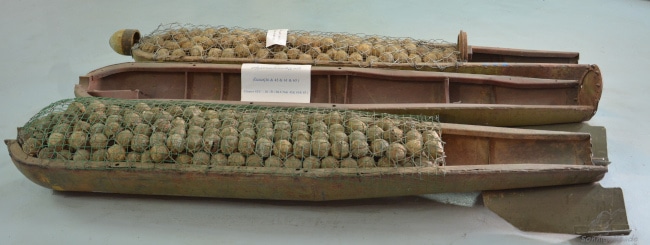
This is reported by the UXO – Information Center. A visit is recommended on the one hand because this time of the bomb war lies as a heavy mortgage until today on the history and development of Laos. I think, for affluent Westerners, who have not been affected by wars for decades, it is a good opportunity to get an idea of the devastating consequences of military conflicts and to think about the situation in the world today.
On the other hand, the visit to the UXO center in Luang Prabang, Laos, is also useful to inform yourself before traveling around the country. Because even in the vicinity of places that are prepared for tourism, such as the Plain of the Jars, there are still dangers from UXO in Laos, as soon as you leave the usual paths for a while. https://www.uxolao.org/luangphrabang
Utopia – where the youth of the world meets
If you are looking for a special place for the evening, then I like to recommend Utopia in Luang Prabang. Utopia is not just a chill pub, it’s more. The operators obviously have the goal to bring people from all over the world together and to create a creative atmosphere where everyone can take away ideas and suggestions on how humanity could develop further – Utopia in fact. On these terraces above the banks of the Nam Khan, there is not only delicious food, but also lectures and discussions, for example about permaculture, cinema evenings with inspiring films, morning yoga (daily 7:30 – 8:30), plenty of space for discussions, chill-out rest areas with a view of the lazily flowing Khan and perhaps also your very conversation partners, who with their impulses and ideas make your life concept a little more tangible. https://utopialuangprabang.com/
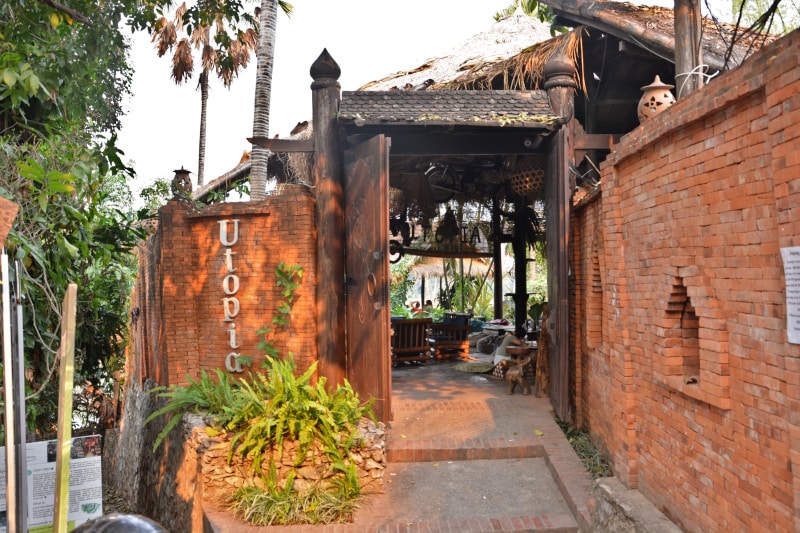
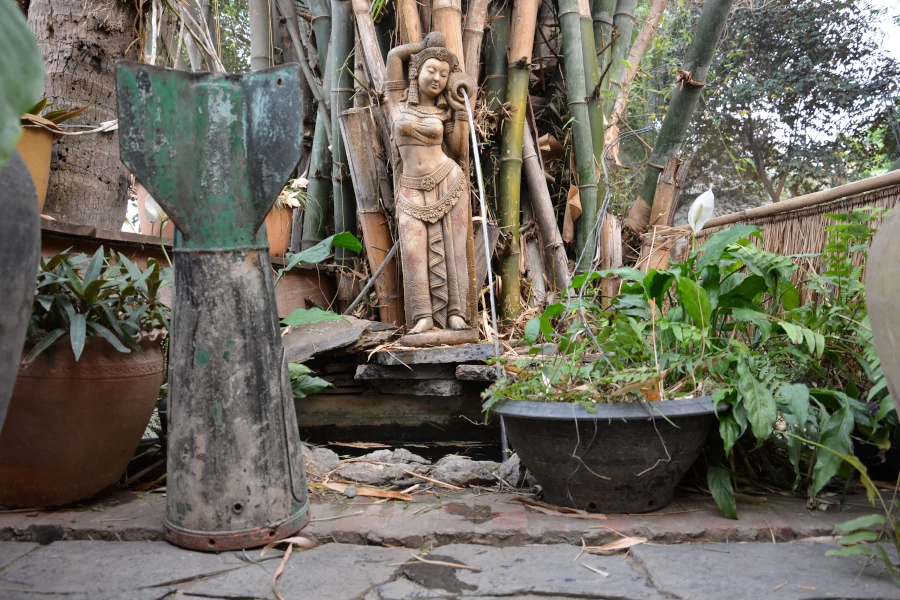
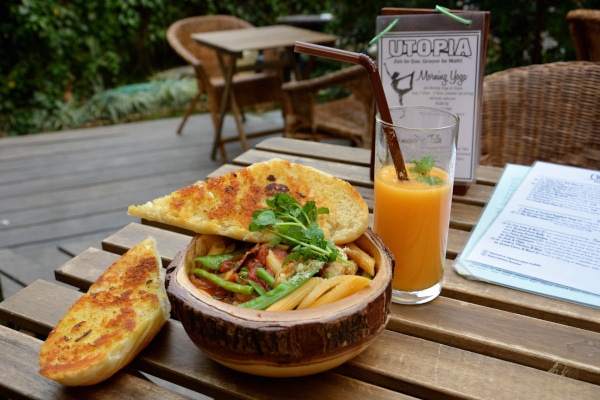
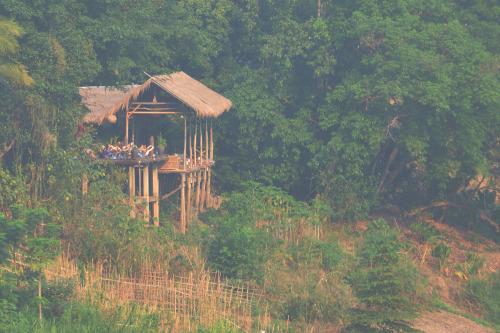
Binthabat – Morning alm of the monks
Something for respectful early risers is the morning alm of the monks bin sai bat. This is not a tourist spectacle! Traditionally, the Buddhist monks are taken care of by local residents – at a morning „begging walk“ where they get their rations for the day. In Luang Prabang with its many monasteries, this morning alm takes place from 5:00 to about 6:30 a.m. For this purpose, the monks pass in long rows the inhabitants, who sit in the streets and pass prepared small food – packets.
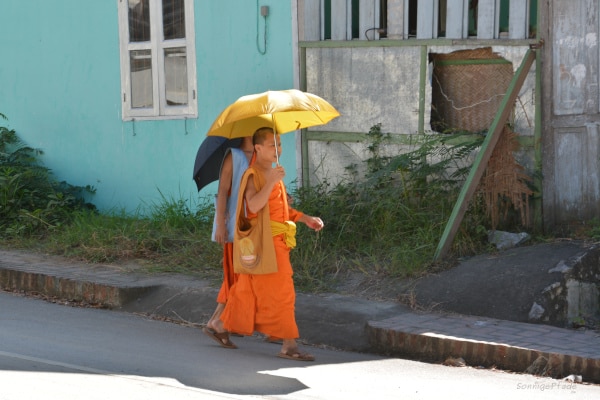
Respect is required here! It is of course possible to watch this and also to take pictures with enough distance (without flash!). Unfortunately, there are now some tourists who want to take insta – photos with the monks or flash them directly in the face.
Please handle this event with dignity! This is not a zoo, but a cultural asset and the monasteries in Luang Prabang are dependent on it. In the meantime, I have even heard of a first monastery moving from the traditional old town area of Luang Prabang, because the supply in this place is no longer provided by enough locals. This is partly due to the fact that fewer and fewer locals live in this quarter, because the historic buildings are increasingly becoming guesthouses and apartments are missing. But it is also due to the fact that tourists consider the morning offering of the locals as a tourist spectacle and make nasty jokes for funny photos…
Places to visit around Luang Prabang in Laos
Pak Ou – limestone caves with Buddha statues
There are also interesting sights in the surroundings of Luang Prabang. One of the most important of them are the limestone caves of Pak Ou, about 25km north on the Mekong River. Some hermit – monks lived there long time ago. Riverboatmen, farmers and local residents have always brought Buddha statues to the caves. During the Indochina war, private citizens also brought their Buddha statues to the Pak Ou caves to save them from destruction. Not all of them were taken away after the war. Thus, several thousand Buddhas ended up in the caves.
The tour to the Pak Ou caves is offered in Luang Prabang as an organized excursion. This is done by boat on the Mekong River or by taxi/ tuktuk over the road to the village of Pak Ou (Pak in Laos refers to the mouth of rivers, so here the Ou river, which flows into the Mekong). From there, access to the cave entrance is by boat. You can book a day tour to the Pak Ou caves with a visit to a village (ethnic Village Tour)*.
If you want to have your special individual Pak Ou Buddha experience, you should start early. Access to the caves is possible from 8:00 a.m., while the mass of tourists arrives from 10… 11. So you can enjoy the magic in the morning haze together with the locals. To do this, you need to organize a tuktuk driver or cab driver in Luang Prabang for the early morning departure to Pak Ou.
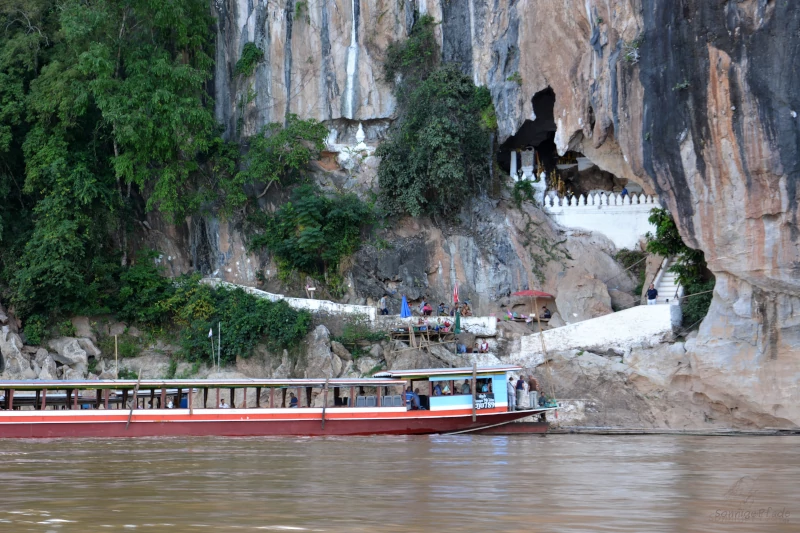
Kuang Si Waterfall
Another destination for a trip from Luang Prabang is Kuang Si Waterfall about 30km southwest of the city. Many local tour operators offer visitor packages there as well – either as a single destination or in combination with one or two other attractions. The waterfall plunges over 30m into the depths and then continues over several terraces that form small pools. If it’s warm enough, you can even swim there. Right next to the waterfall there is a Bear Rescue Centre, where bears from captivity are now allowed to enjoy a bit more freedom again in larger enclosures. You can book a tour with the Long tail boat and bike tour to Kuang Si here*.
Mandalao Elephant – Resort
The treatment of elephants is a controversial issue not only in Thailand but also in Laos. Wild elephants, of which once there were millions in the Lan Xang Empire, are now a rarity. Also in the surroundings of Luang Prabang there are stations which offer elephant riding for tourists. However, it is pleasing that especially in Luang Prabang several local tour operators consciously organize tours to elephant resorts, which are not about riding, but about the care and rehabilitation of former working elephants and which are of course financed with the visitors‘ money and donations from guests. So if you want your elephant experience in the Luang Prabang area, check out the offer of „Mandalao“ in Thanon Sisavangvong Road. https://mandalaotours.com/
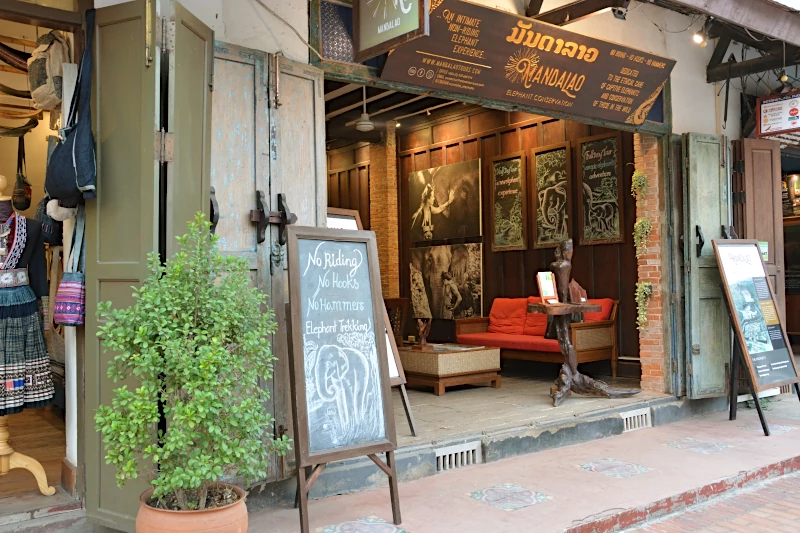
Travel tips for Luang Prabang
Luang Prabang hotels and guesthouses
Best accommodation in Luang Prabang
The *****Luang Prabang View Hotel* on the periphery of the World Heritage – Center offers excellent accommodations in air-conditioned two- to five-bed rooms suitable for families. Individual rooms are wheelchair accessible. A large outdoor pool provides a view of the old town. Local as well as Western food is also offered in the restaurant or café bar. Car rental and bicycle rental are arranged by the hotel. For children, there’s an indoor play area and baby or child care, if needed.
One of the top addresses in the historic world heritage center of Luang Prabang is the 3 Nagas ****Hotel* on Sakkaline Road, which is spread over three old colonial buildings in French style. Tea and coffee facilities are part of the room equipment, but the hotel also has its own „Nagini – Bar“ and a restaurant. The hotel’s garden can also be used for recreation. The house rents bicycles for its guests.
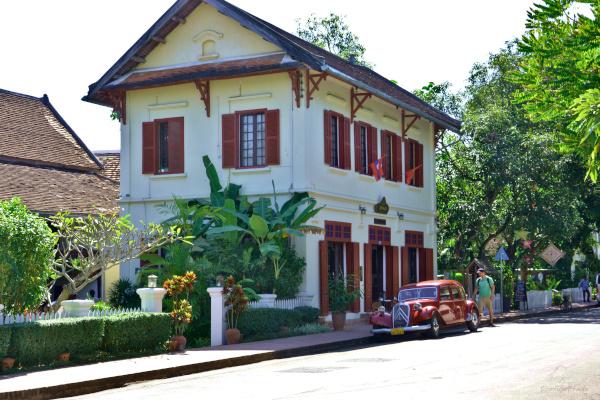
… just outside
About 5km outside of Luang Prabang is the excellent *****Rosewood Hotel* and guesthouse with various offers in a beautiful landscape. Mountains, jungle and waterfall surround the various accommodations, which are located in colonial-style villas, suites by the river or a tent on the mountain. Depending on the accommodation, two to four guests will find their nightly quarters. Some of the villas have a separate pool. The accommodation offers its guests Laotian wellness – offers and massages. Laotian dishes or French cuisine are offered for breakfast. Rosewood Hotel has a bicycle rental service and also organizes outdoor activities such as trekking and mountain-biking. A shuttle service is offered.
Good value accommodation for individual travelers
The Maison Vongprachan Hotel* is located close to the action in the center of Luang Prabang in an old colonial house and is one of the very good accommodations with air-conditioned two-bed rooms. A family room is also available. The hotel service can arrange scooters and rental bikes for guests. For breakfast, the hotel has a choice of local offerings or a Western breakfast.
Sala Prabang Hotel* is located directly on the Mekong River overlooking the World Heritage Site – Old Town. Double rooms are offered in this French colonial house with an upgrade if necessary. There is a breakfast restaurant on the ground floor with terrace facing the Mekong River. All rooms of the hotel have coffee / tea facilities.
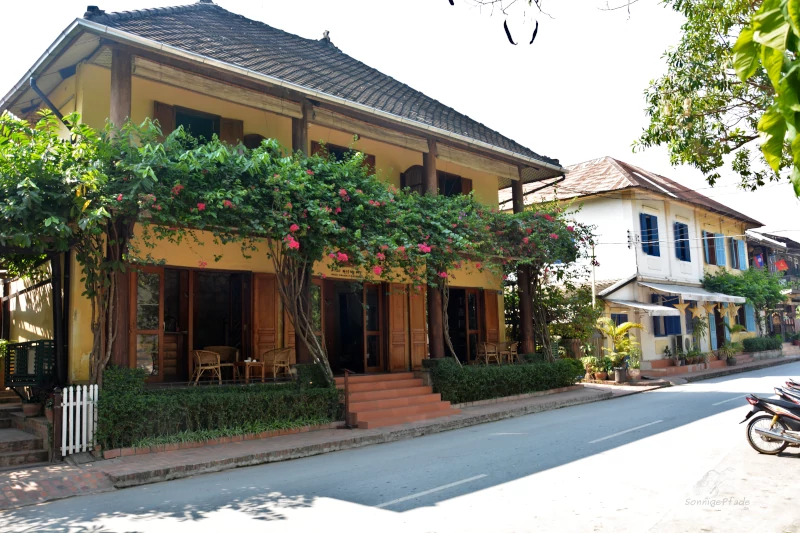
Right on the Khan River overlooking the temporary bamboo bridge, Saynamkhan Riverview Guesthouse* is located in Luang Prabang’s Old Town. Both Mount Phousy and the National Museum in the Royal Palace are about a 5-minute walk away. To Utopia Restaurant it is about 10 min. The hotel offers double rooms if necessary with extension. Scooters or cars for individual exploration of the area can be rented at the hotel.

Budget accommodation – hostels in Luang Prabang
Conveniently located for sightseeing in Luang Prabang Old Town, Y-Not-Laos Hostel* offers accommodation in dorm beds. Breakfast is included in the accommodation. The hostel also provides rental bicycles and scooters for your individual tour of the Luang Prabang area.
Among the cheaper accommodations in Luang Prabang is the popular Downtown backpackers Hostel 2*, where twin rooms (with extension if necessary), a family room and various dorm beds are available. A continental breakfast is available. The hostel’s communal lounge is popular for sharing experiences and planning joint activities among guests. It is about 600m walk to the National Museum in the center.
Exclusively offering accommodation in dorm beds, Vongprachan Backpackers Hostel* is located around 300m from Phousy Hill. Each room has its own bathroom area. Scooters can also be rented through the hostel.
Arrival
Luang Prabang is a transportation hub, even if it is hardly comparable with European standards. But there are bus connections, even internationally from Thailand and Vietnam, there is a (tiny) international airport, boats sail on the Mekong River and since summer 2022 the China – Laos railroad runs from the Laotian capital Vientiane via Luang Prabang to China.
By plane to Luang Prabang
So there are many possibilities. Until now, the airplane was by far the fastest connection to Luang Prabang. For long-distance travelers, the direct connection to the Bangkok hub in Thailand was (and still is) particularly interesting. There were and are further flights in the region – to Vientiane and to Hanoi (Vietnam), and – as far as resumed after the Corona – break – to Chiang Mai in northern Thailand and Siem Reap in Cambodia, i.e. the place of the tourist highlight Angkor Wat.
The new China – Laos Railway
With the China – Laos Railway, the connection between Luang Prabang and Vientiane has been significantly accelerated since 2022. If buses previously traveled for over 8 hours on the road known as the National Highway (which was in part only a gravel track), there are now rail connections of about 3 hours for the approximately 320-kilometer route. In addition, however, there is the journey to the station – the railroad line makes a large arc east around Luang Prabang and the station is located far outside.
By bus to Luang Prabang and the region
I almost always traveled by bus. From and to Vientiane I used mainly the nightly sleeper bus connections. This is practical – if you leave in the evening between 10 and 12 p.m, you are at your destination the other morning. And in the sleeper bus the night is relatively restful. The rail connection was still under construction during my last stay. Buses also run in east – west direction from Hanoi / Vietnam via Luang Prabang in Laos to Chiang Mai / Thailand.
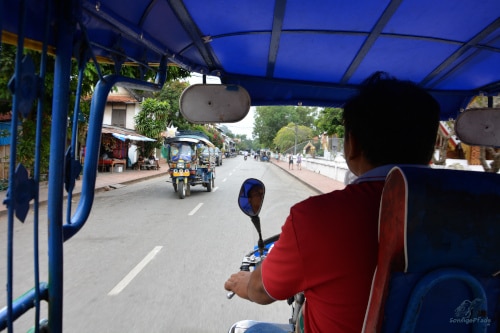
From and to Luang Prabang there are also buses to the province of Xieng Khouang, where you can find the „Plain of Jars“ or to the northern provinces of Laos. It is important for you to know that there are two bus stations in Luang Prabang. The northern bus station near the airport serves the northern provinces. To Xieng Khouang, Vientiane, Vang Vieng and other regions you will come from the southern bus station. Usually you will go to the bus stations by TukTuk, so it is important to tell the driver clearly where your destination is. However, on my last visits to Luang Prabang, I walked to the bus stations, which is also doable (around 2km from the center).
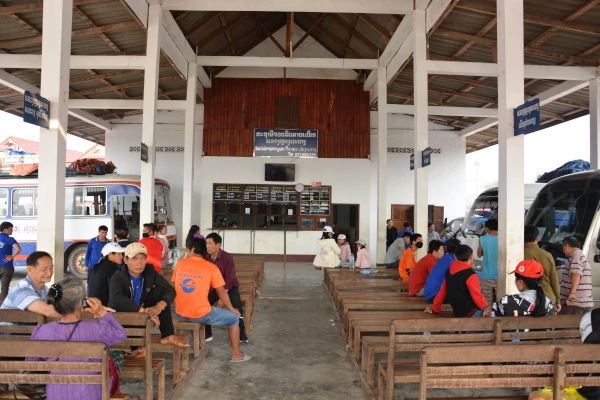
By river boat on the Mekong
Exciting and „authentically Lao“ is the journey to Luang Prabang by boat on the Mekong river. From Chiang Kong in northern Thailand, you can cross over to the Lao side of the Mekong to Houay Xay via one of the new „friendship bridges“. From there river boats go in 2 days to Luang Prabang with stopover and overnight stay in Pakbeng. Once such a trip is definitely recommended – so you get to know the country in a regionally typical way. The river boats are still important means of transport for people and goods, especially in the north of Laos. Of course there are also boats in the opposite direction.
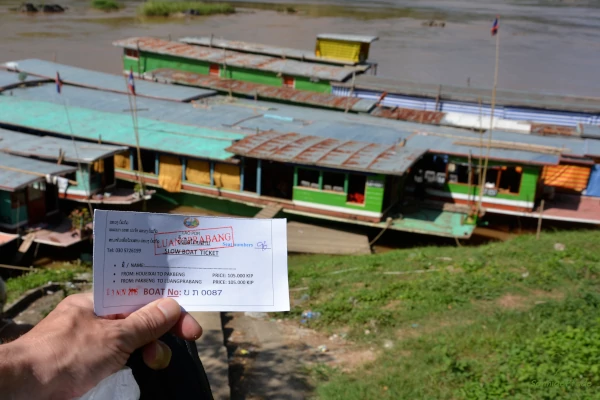
Money in Laos
In Laos, the Lao Kip is used as a means of payment. Roughly speaking, 25,000 Kip is about 1 £. It is almost normal that you are a millionaire after visiting the ATM. But the joy does not last long, the Kip are quite „liquid“ and the fancy bills rush pretty quickly through the fingers.
Because Laos is comparatively expensive for Southeast Asia. When withdrawing money from the many ATMs, an ATM fee is due. However, the fee has been relatively moderate so far. If you plan to travel to rural areas, get enough cash beforehand. Because not everywhere there are (functioning) ATMs.
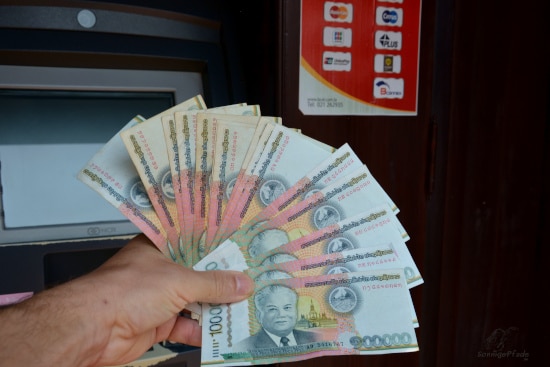
You should also pay attention to the spelling on the banknotes. On the one hand there are Latin numbers and on the other hand there are numbers written in Lao on the money. There a 100,000 Kip – bill appears already times like 900,000 works! (See in the picture the numbers on the left below the thumb and on the right edge) So simply is not become rich then nevertheless….
The entry to Laos
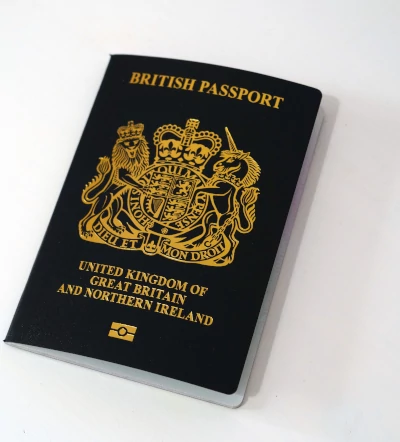
The entry is possible through most border crossings with visa on arrival. That is, you fill out a visa application form on the spot and for a fee of 20 or 30 US dollars you get your visa for 30 days pasted into your passport directly at the border crossing. Until now, you had to hand in your passport pictures, but now there are web-cams at the Laotian border crossings, with which the border officials take a picture of you. But I usually have a set of self-made passport pictures with me – as „photo stickers“ from a discount photo shop.
Inform yourself beforehand about the restrictions of visa on arrival for certain border crossings, there were some restrictions recently.
The weather and the best time to travel
Weather in Luang Prabang in Laos today and in the next three days
The best time for travelling to Laos is during the dry season. It starts around the beginning of November and lasts until March. Daytime temperatures can regularly exceed 30°C from February to April, but you also have to expect cooler nights (14°C) and fresh morning temperatures in the north of Laos.
In fact, during the dry season, rain showers are rare. But when it does start, it can really come down! Especially since climate change does not stop in front of Laos, which can mean increasing instability in the usual rhythms here. From May to October in Luang Prabang are the rainiest months of the rainy season. In July and August there is about 225mm of precipitation. In December, January and February, on the other hand, there is only about 15mm.
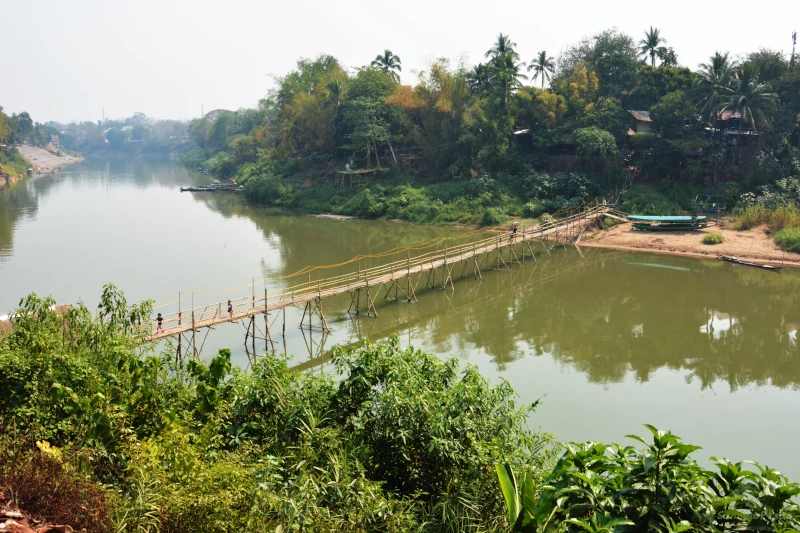
Time difference and time zone for Laos
In Laos, the so-called Indochina time applies, as in Thailand and Vietnam. This means a shift compared to Central European Time (CET) by 6 hours or 7 hours to GMT, which Laos is ahead of Europe. When arriving directly, this means a decent jetlag…
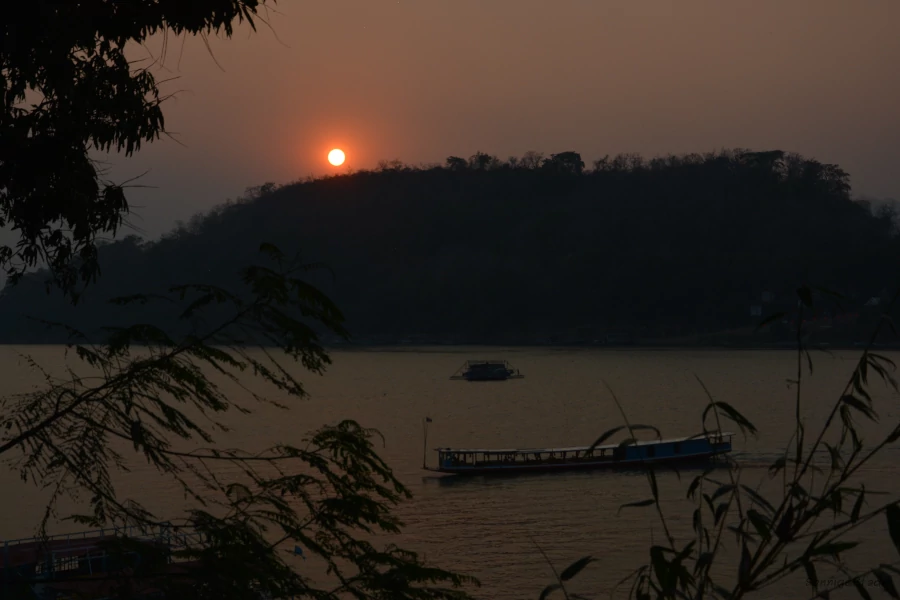
Fancy a visit to Luang Prabang? Invite your friends!
If you liked the post about Luang Prabang, share the link to the post on your social media channels and make your friends curious! A positive echo in the internet – sphere by sharing and recommending also helps the search engines to separate the „wheat from the chaff“ and to present good posts further in front in the search results. Thank you!
Finally, and as a small summary, here is a Luang Prabang FAQ:
Luang Prabang is located in the north of the southeast Asian country of Laos on the Mekong River – between the northern regions of Thailand around Chiang Mai and northern Vietnam.
Laos is a small landlocked country on the southeast Asian peninsula. It has no access to the sea; the upper reaches of the Mekong flow through Laos along its entire north-south expanse. Thailand borders Laos to the west, Myanmar and China to the north, Vietnam to the east and Cambodia to the south.
The capital of Laos is Vientiane. This city is also located on the Mekong River, which forms the border with Thailand. Vientiane is connected to Luang Prabang by domestic flights and, since 2022, by the China – Lao Railway.
Of course! Luang Prabang did not become a World Heritage city for nothing. The wonderful location on the Mekong, the richly decorated temples and French colonial buildings offer a unique mixture that is special for the whole of Southeast Asia.
There are various ways to get to Luang Prabang. The easiest way is by plane, e.g. from Bangkok or from the Laotian capital Vientiane. Since 2022, there has also been a railroad from China to Vientiane, which connects Luang Prabang with the capital very quickly. Buses travel to Luang Prabang from various parts of the country, but also from Thailand (Chiang Mai) or Vietnam. A boat trip on the Mekong can be a special experience when traveling to Luang Prabang.
In 1365, the Lan Xang Empire was founded in the north of present-day Laos as an offshoot of the Khmer Empire of Angkor. Luang Prabang became the new capital of this empire. To honor the authority of the king, Luang Prabang received the Buddha statue Phra Bang from Angkor, from which the name of the city is derived. There is no record of how long the settlement had already existed.
A visit to the historic center with its numerous Buddhist monasteries is practically a must-do in the World Heritage city of Luang Prabang. We recommend a visit to the former royal palace, which now houses a national museum. There are also evening theater performances. Directly opposite is an ascent to Mount Phousi, from where you can enjoy a panoramic view over Luang Prabang, the Mekong and the surrounding mountains. Those interested in the many peoples and ethnic groups in northern Laos should visit the exhibition at the Traditional Arts and Ethnology Center (TAEC), where crafts, life, folk art and music are illustrated. Boat trips on the Mekong, e.g. at sunset, are another activity. A visit to the cultural restaurant UTOPIA brings together the youth of the world. You can stroll and store at the night market in Luang Prabang, where many ethnic groups offer their handicrafts as souvenirs. Local tour operators organize day trips to the Buddha caves of Pak Ou or various waterfalls (some with swimming opportunities).
That depends on your interests, of course. I have been to Luang Prabang several times for several days – 3 days is the minimum, I think: city tour, national museum, night market 1 day, begging of the monks in the morning, various monasteries, ascent to Phousi Hill, TAEC exhibition, evening at UTOPIA 2. Day 2, UXO information and exhibition, take the ferry to the other side of the Mekong (visit more remote monasteries), riverside restaurants, simply enjoy life on the Mekong, boat trip at sunset Day 3, excursions in the surrounding area (Buddha caves, waterfalls…) Day 4 Due to the heat at midday, you should plan an extended siesta 😉
The people in Luang Prabang are generally friendly and helpful, sometimes perhaps a little reserved towards strangers. Nevertheless, as in many tourist hotspots, it cannot be completely ruled out that some people seek a way out by stealing, mainly out of necessity. Caution is therefore advisable in this respect, as in any tourist region. As far as cluster munitions (UXO… unexploded ordnaries) from the Vietnam and Laos wars are concerned, Luang Prabang is largely safe. However, anyone traveling into the surrounding area should be careful and only use roads. Information on this problem in Laos can be found in the exhibition at the UXO Information Center in Luang Prabang (and in many other towns in Laos).
Note on * advertising links
Some links in the article are marked with *. These are advertising links to online – stores or agencies. If you follow the links and buy or book something, the sonnige pfade blog receives a small commission to cover the technical expenses. Nothing will be more expensive for you, because the commission is already calculated by the providers in the pricing.
Picture source: ¹Photo by Ethan Wilkinson on Unsplash